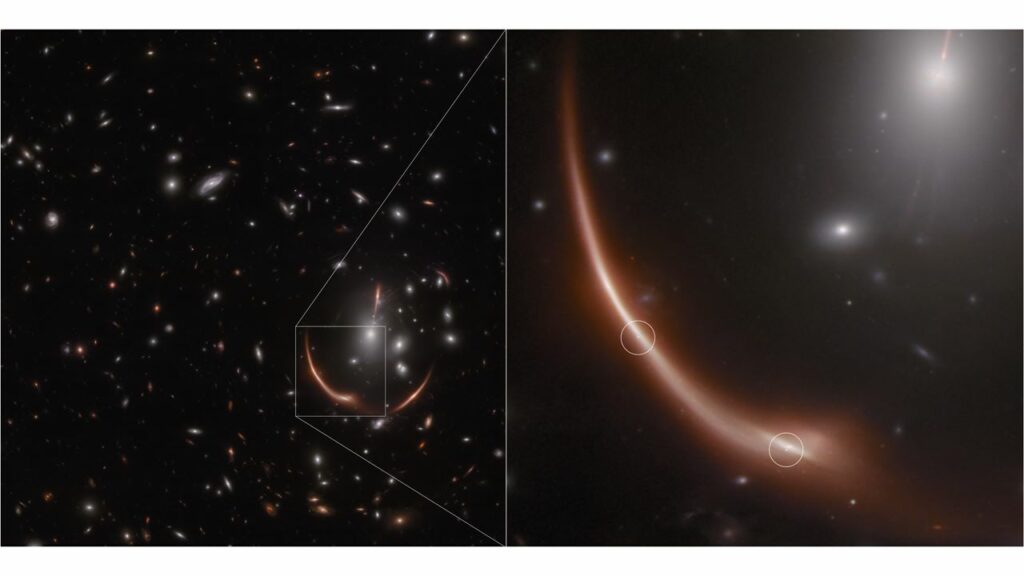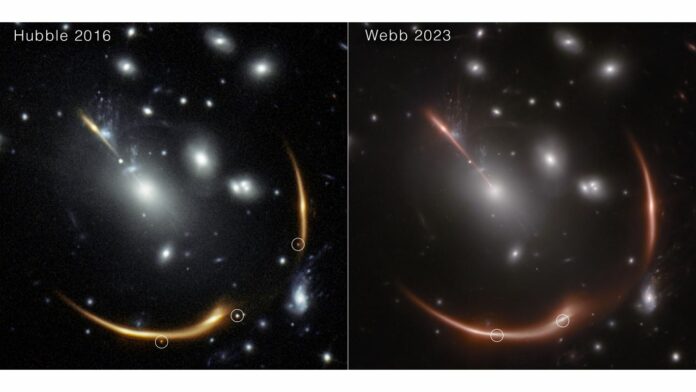In November 2023, NASA’s James Webb Space Telescope captured an image of a huge cluster of galaxies called MACS J0138.0-2155. Using gravitational lensing, a phenomenon predicted by Albert Einstein, a distant galaxy called MRG-M0138 is distorted by the strong gravity of the galaxy cluster. This gravitational lensing warps and magnifies the distant galaxy and creates five separate images of MRG-M0138.
In 2019, astronomers revealed the discovery of a supernova within the galaxy MRG-M0138, as observed by NASA’s Hubble Space Telescope in 2016. Upon examining images from the James Webb Space Telescope in 2023, another group of astronomers made an unexpected observation: a second supernova had occurred in the same galaxy seven years later.
This marks the first instance of finding two gravitationally lensed supernovae in the same galaxy. Justin Pierel (NASA Einstein Fellow at the Space Telescope Science Institute) and Andrew Newman (staff astronomer at the Observatories of the Carnegie Institution for Science) provide further insights into this remarkable discovery.
Justin Pierel (NASA Einstein Fellow at the Space Telescope Science Institute) said, “When a supernova explodes behind a gravitational lens, its light reaches Earth by several different paths. We can compare these paths to several trains that leave a station simultaneously, all traveling at the same speed and bound for the same location. Each train takes a different route, and because of the differences in trip length and terrain, the trains do not arrive at their destination simultaneously.”
“Similarly, gravitationally lensed supernova images appear to astronomers over days, weeks, or even years. By measuring differences in the times that the supernova images appear, we can measure the history of the universe’s expansion rate, known as the Hubble constant, which is a major challenge in cosmology today. The catch is that these multiply-imaged supernovae are extremely rare: fewer than a dozen have been detected until now.”
The 2016 supernova in MRG-M0138, named Requiem, was unique for several reasons. First, it was located 10 billion light-years away. Second, the supernova belonged to the type Ia category, commonly used as a ‘standard candle’ for measuring cosmic distances.

Third, models predicted a delayed appearance of one supernova image due to its path through the intense gravity of the cluster, making it visible to us only in the mid-2030s. Unfortunately, Requiem wasn’t discovered until 2019, after it had faded from view, preventing the gathering of sufficient data to measure the Hubble constant.
The serendipitous discovery of a second gravitationally lensed supernova within the same galaxy as Requiem, named Supernova Encore. Scientists actively monitor Encore with a time-critical director’s discretionary program using Webb images. Based on this multiply imaged supernova, the goal is to measure and confirm the Hubble constant. Encore is identified as a standard candle or type Ia supernova, making Encore and Requiem the most distant pair of standard-candle supernova ‘siblings’ ever discovered.
Scientists noted, “Supernovae are normally unpredictable, but in this case, we know when and where to look to see the final appearances of Requiem and Encore. Infrared observations around 2035 will catch their last hurrah and deliver a new and precise measurement of the Hubble constant.”
